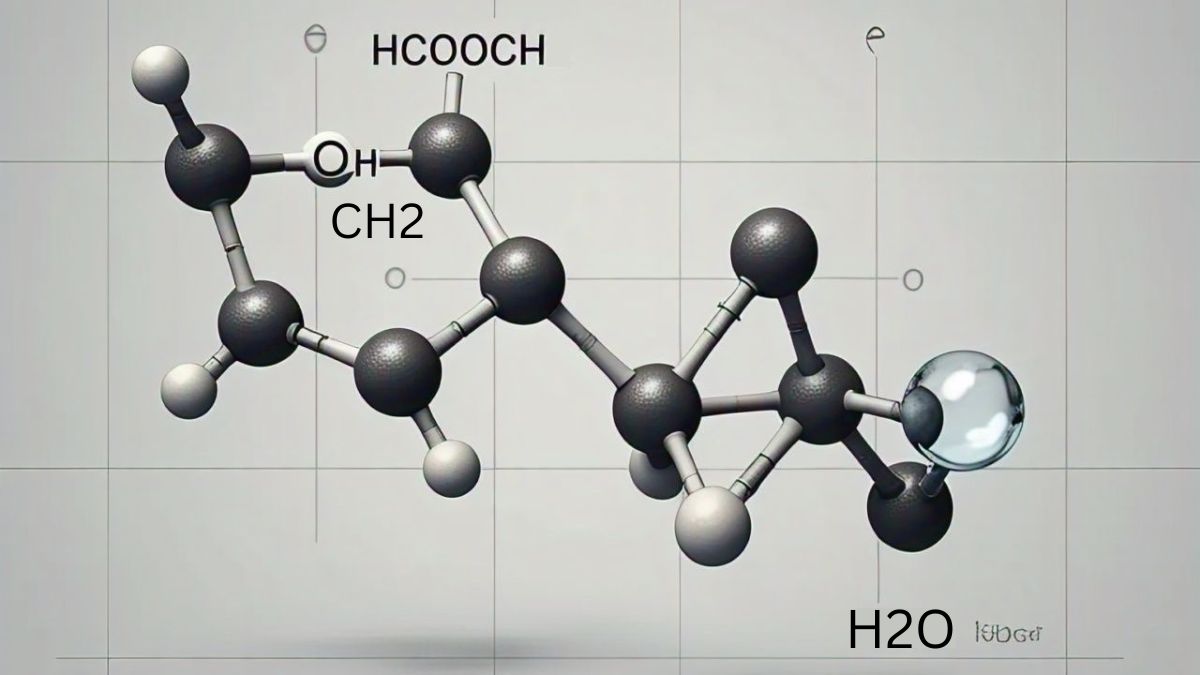Chemistry is the foundation of understanding molecular interactions and the transformations that drive both natural and industrial processes. The formula hcooch ch2 h2o suggests a combination of a formate ester, an alkene (ethylene), and water, each of which plays a significant role in organic chemistry. These compounds participate in various reactions, leading to the synthesis of essential chemicals used in different industries. This article explores the properties, chemical reactions, and industrial applications of these compounds in detail.
Understanding the Components
Formate Ester (HCOOCH)
Formate esters are organic compounds containing the formate (-HCOO) functional group attached to an alkyl or aryl group. These esters are crucial in synthetic chemistry due to their ability to participate in hydrolysis, reduction, and esterification reactions. They serve as intermediates in producing solvents, plasticizers, and pharmaceutical ingredients. The chemical behavior of formate esters depends on the presence of catalysts and reaction conditions.
Ethylene (CH₂=CH₂)
Ethylene is one of the simplest and most fundamental alkenes in organic chemistry. It consists of two carbon atoms connected by a double bond, making it highly reactive in addition reactions. Ethylene is widely used as a precursor in polymer production, particularly for manufacturing polyethylene plastics, which are essential in packaging and consumer products. Additionally, ethylene serves as a plant hormone that regulates fruit ripening.
Water (H₂O)
Water is a universal solvent and a key reactant in numerous chemical processes. It facilitates hydrolysis, hydration, and condensation reactions, making it indispensable in industrial and biological systems. Water also acts as a medium for catalytic reactions, enhancing the solubility and reactivity of various compounds.
Key Chemical Reactions and Transformations of hcooch ch2 h2o
Hydrolysis of Formate Ester
The hydrolysis of formate esters occurs in the presence of water and can be catalyzed by acids or bases. This reaction breaks the ester bond, yielding formic acid and an alcohol:
This reaction is widely used in industrial processes to produce formic acid, which has applications in agriculture, textiles, and food preservation. Methanol, the alcohol byproduct, is also valuable in the production of biofuels and chemical synthesis.
Hydration of Ethylene to Ethanol
Ethylene undergoes hydration when reacted with water in the presence of an acid catalyst, leading to the formation of ethanol:
Ethanol is a crucial industrial compound used in alcoholic beverages, antiseptics, and biofuels. This reaction is essential for large-scale ethanol production, reducing reliance on fossil fuels and supporting sustainable energy initiatives.
Esterification Reactions
A reversible reaction between formic acid (HCOOH) and an alcohol such as methanol can regenerate a formate ester:
This esterification process is widely used in the fragrance and flavoring industries to synthesize esters with desirable scents and tastes. It is also employed in the production of biodegradable solvents and intermediates for pharmaceuticals.
Industrial and Commercial Applications
Polymer Production and Material Science
Ethylene serves as the primary raw material for polyethylene (PE) plastics, which are used in consumer packaging, medical devices, and construction materials. The polymerization of ethylene forms high-density and low-density polyethylene, each with unique properties suited for different applications.
Pharmaceutical and Chemical Synthesis
Formate esters and ethylene derivatives are essential in the synthesis of pharmaceutical drugs and industrial solvents. Methanol, derived from ester hydrolysis, acts as a feedstock for producing formaldehyde, which is used in resin production and disinfectants.
Agriculture and Food Industry
Ethylene plays a significant role in agriculture as a natural plant hormone that accelerates fruit ripening. This property is utilized in controlled ripening chambers for fruits such as bananas and tomatoes. Additionally, formic acid, a hydrolysis byproduct, is used as a food preservative and antibacterial agent in livestock feed.
Renewable Energy and Biofuels
Ethanol production from ethylene hydration is a key component of the renewable energy sector. Ethanol is blended with gasoline to create biofuels, reducing carbon emissions and enhancing fuel efficiency. Methanol, another hydrolysis product, is also being explored as an alternative energy source for clean-burning fuels.
Future Developments and Innovations
Advanced Catalysis in Chemical Reactions
Ongoing research aims to improve catalytic efficiency in hydrolysis and esterification reactions to enhance yields and reduce environmental impact. The development of green catalysts could revolutionize industrial chemistry by minimizing waste and energy consumption.
Sustainable Polymer Alternatives
As concerns over plastic pollution grow, scientists are investigating bio-based alternatives to polyethylene. By utilizing plant-derived ethylene sources, manufacturers can develop biodegradable plastics that maintain durability while reducing ecological impact.
Enhanced Ethanol Production Techniques
New biotechnological methods are being developed to optimize ethanol production from renewable sources, such as biomass and agricultural waste. These advancements could lower production costs and contribute to the global shift toward sustainable energy.
Formate Esters in Green Chemistry
Formate esters are being explored as potential eco-friendly solvents in chemical processing. Their low toxicity and biodegradability make them promising candidates for replacing hazardous petrochemical solvents in industrial applications.
Conclusion
The combination of hcooch ch2 h2o results in a variety of chemical reactions that have significant industrial and commercial implications. From the production of essential chemicals to advancements in renewable energy, these compounds contribute to numerous scientific and technological advancements. Understanding their interactions allows researchers and industries to develop innovative solutions that enhance sustainability and efficiency across multiple sectors.
FAQs
1. What is the significance of ethylene in industrial chemistry?
Ethylene is a fundamental building block for producing polyethylene plastics, ethanol, and various chemical intermediates, making it essential in the manufacturing and materials industry.
2. How is ethanol produced from ethylene and water?
Ethanol is synthesized through the acid-catalyzed hydration of ethylene, a widely used method in industrial alcohol production.
3. Why are formate esters important in organic synthesis?
Formate esters serve as intermediates in the production of solvents, fragrances, and pharmaceuticals due to their versatility in esterification and hydrolysis reactions.
4. What are the environmental benefits of bioethanol production?
Bioethanol reduces greenhouse gas emissions by providing a renewable alternative to fossil fuels, contributing to cleaner energy solutions.
5. How is water involved in chemical transformations?
Water acts as a solvent, reactant, and catalyst in hydrolysis, hydration, and esterification reactions, playing a crucial role in numerous chemical processes.

